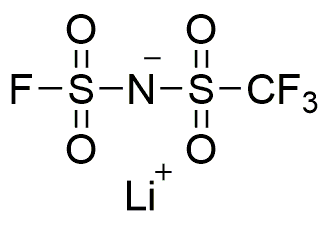Lithium (fluorosulfonyl)(trifluoromethanesulfonyl)imide is widely utilized in research focused on:
- Electrolytes for Batteries: This compound serves as a highly effective electrolyte in lithium-ion batteries, enhancing their performance and longevity. Its unique properties allow for better ion conductivity, which is crucial for energy storage applications.
- Advanced Energy Storage Solutions: In the development of solid-state batteries, this chemical improves thermal stability and safety, making it a preferred choice for next-generation energy storage systems.
- Electrochemical Devices: It is used in various electrochemical devices, including supercapacitors, where it helps in achieving higher energy densities and faster charge/discharge rates.
- Research in Ionic Liquids: The compound is explored in the formulation of ionic liquids, which are used in green chemistry applications due to their low volatility and high thermal stability.
- Polymer Electrolytes: It is incorporated into polymer electrolyte membranes, improving their ionic conductivity and mechanical properties, which are essential for fuel cell technologies.
General Information
Properties
Safety and Regulations
Applications
Lithium (fluorosulfonyl)(trifluoromethanesulfonyl)imide is widely utilized in research focused on:
- Electrolytes for Batteries: This compound serves as a highly effective electrolyte in lithium-ion batteries, enhancing their performance and longevity. Its unique properties allow for better ion conductivity, which is crucial for energy storage applications.
- Advanced Energy Storage Solutions: In the development of solid-state batteries, this chemical improves thermal stability and safety, making it a preferred choice for next-generation energy storage systems.
- Electrochemical Devices: It is used in various electrochemical devices, including supercapacitors, where it helps in achieving higher energy densities and faster charge/discharge rates.
- Research in Ionic Liquids: The compound is explored in the formulation of ionic liquids, which are used in green chemistry applications due to their low volatility and high thermal stability.
- Polymer Electrolytes: It is incorporated into polymer electrolyte membranes, improving their ionic conductivity and mechanical properties, which are essential for fuel cell technologies.
Documents
Safety Data Sheets (SDS)
The SDS provides comprehensive safety information on handling, storage, and disposal of the product.
Product Specification (PS)
The PS provides a comprehensive breakdown of the product’s properties, including chemical composition, physical state, purity, and storage requirements. It also details acceptable quality ranges and the product's intended applications.
Certificates of Analysis (COA)
Search for Certificates of Analysis (COA) by entering the products Lot Number. Lot and Batch Numbers can be found on a product’s label following the words ‘Lot’ or ‘Batch’.
*Catalog Number
*Lot Number
Certificates Of Origin (COO)
This COO confirms the country where the product was manufactured, and also details the materials and components used in it and whether it is derived from natural, synthetic, or other specific sources. This certificate may be required for customs, trade, and regulatory compliance.
*Catalog Number
*Lot Number
Safety Data Sheets (SDS)
The SDS provides comprehensive safety information on handling, storage, and disposal of the product.
DownloadProduct Specification (PS)
The PS provides a comprehensive breakdown of the product’s properties, including chemical composition, physical state, purity, and storage requirements. It also details acceptable quality ranges and the product's intended applications.
DownloadCertificates of Analysis (COA)
Search for Certificates of Analysis (COA) by entering the products Lot Number. Lot and Batch Numbers can be found on a product’s label following the words ‘Lot’ or ‘Batch’.
*Catalog Number
*Lot Number
Certificates Of Origin (COO)
This COO confirms the country where the product was manufactured, and also details the materials and components used in it and whether it is derived from natural, synthetic, or other specific sources. This certificate may be required for customs, trade, and regulatory compliance.


